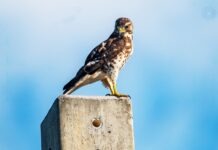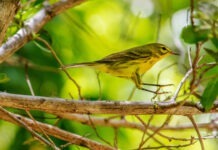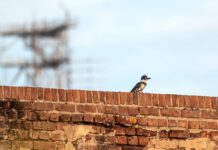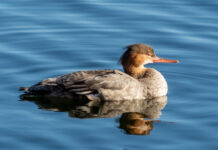The thing that rocked me back on my heels most in recent years, avian taxonomy-wise, is the fact that falcons are not closely related to hawks and eagles. Using DNA analysis, avian taxonomists – the people who figure out which bird species are related to which, and where they all fit in the evolutionary tree – have learned that falcons are actually most closely related to parrots. They just happen to do many of the same things to survive as the other birds of prey – most obviously eating other birds, as well as the occasional reptile, insect or small mammal. (This is an example of convergent evolution.)
Basically, falcons and parrots shared a common ancestor species, and over the millennia some of that species’ descendants embraced the role of colorful, loud, (mostly) vegetarians with serious mimicry skills, and some of that species’ descendants became speedy, carnivorous assassins. (This is an example of divergent evolution.)
We tend to think of parrots as tropical exotic creatures from distant lands, despite the names of some Keys hotels, but we did once have a species of parrots in the United States – the Carolina parakeet. Unfortunately we hunted it to extinction – a process exacerbated by their tendency, when one of their members went down, to return and see what happened.
We nearly wiped out the falcons in the U.S. in the 1960s and 1970s, but fortunately banned DDT and other organochlorine pesticides, enabling their numbers to rebound somewhat over the decades.
We regularly get three species of falcons here in the Keys. The largest (and fastest) are the peregrine falcons, standing an average of 16 inches tall and weighing in at a pound-and-a-quarter, which tend mostly to migrate through in September and October.
Next in size are the merlins, standing an average of 10 inches tall and weighing an average of .4 pounds. They tend to keep a similar schedule as the peregrines in the Keys.
Smallest are the American kestrels, standing an average of 9 inches tall and weighing in at a quarter-pound. They, too, come into the Keys in the fall, but a good number decide to stay for the winter. In Key West it can be difficult to travel a few blocks without seeing one perched on a wire. In the past week two of them worked out a turf battle in my backyard mahogany tree. And while writing the above paragraphs I heard one calling several times while flying around Bayview Park.
While most falcons tend to not make a lot of noise unless they’re in distress or seeking the attention of a mate, American kestrels are chatty little beasts with a distinctive klee klee klee call that prompted generations of Conchs to refer to them as klee klee hawks. There was even a kids’ game called 1-2-3 Klee Klee — basically an aggressive version of tag, in which the person who’s “it” has to catch the shirt of another player and hold on long enough to say, “1-2-3 Klee Klee.” Jordan Holtkamp once explained the rules to me when he grabbed my shirt and shook me like a rag doll in the aisles of Strunk Ace Hardware.
Conch lore also says that if you hear the klee klee call in the late fall, it’s safe to take your storm shutters down, though Hurricane Wilma (Oct. 24, 2005) disproved that theory.
Most falcons have what is called a malar stripe, a dark streak below the eye that absorbs glare, much like the eye-black paint football players wear for the same reason. American kestrels actually have two streaks below each eye.
Females are a streaked whiskey brown that skews towards tiger orange. Males have similar coloring, but with a silky cerulean blue in the wings and on top of their head.
There are 15 species of kestrel in the world. The name comes from the Eurasian kestrel, which most Eurasians just refer to as the kestrel, and is probably derived from their call, which apparently sounded, to the Old World ear, something like a noisy bell or a “leper’s clicket.”
The first definition of “clicket” I found defined it as copulation, generally among foxes or hares, which didn’t make sense, but a further definition was a noisemaker beggars once used to gain attention in crowded public spaces. That made more sense.
One of the marked traits of kestrels is their ability to hover-flap in the air, or ride wind currents, usually over open fields, for long periods, before swooping down to strike their prey – usually a small bird, mouse or cricket. (Lenny Carey, who used to teach at Key West High School, apparently had trained a neighborhood American kestrel to come and take crickets from his hand.)
It’s amazing to see, as their whole body tends to be in motion, adjusting to the air currents around them, while their heads stay stock still, as if attached to some invisible mount. More often in the Keys, where we don’t have a lot of updrafts or open fields, they tend to sit on wires or lampposts, waiting to fall on unsuspecting prey.
They are so good at the wind-riding thing, one of their names in England in the 1600s was “the windf*cker.” The name, sadly, is not used as often in modern times, though it may be worth an attempted resurgence. Apparently “f*ckwind” was also in vogue briefly in the 1800s.
The American kestrel is the only kestrel found in the New World. Genetic analysis of different species has done a good bit to unravel and then re-ravel what we think we know about the world. And the current thinking is that the American kestrel, despite its wind-riding abilities, may not taxonomically be a true kestrel, like the 14 other species of kestrel, but rather more closely related to western North American falcons, such as the Aplomado falcon. (There’s that convergent evolution again.)
All of this is a long walk to explain why a klee klee hawk may not actually be a windf*cker. But if they decide to rename the American kestrel due to this new knowledge, maybe they’ll give serious consideration to klee klee falcon.

























